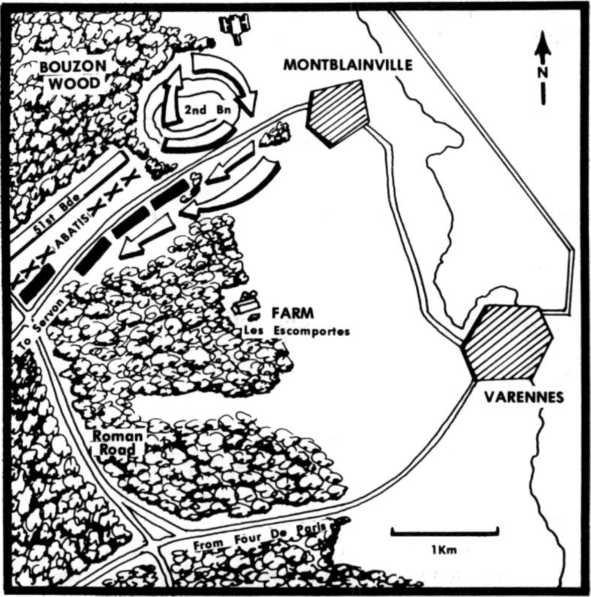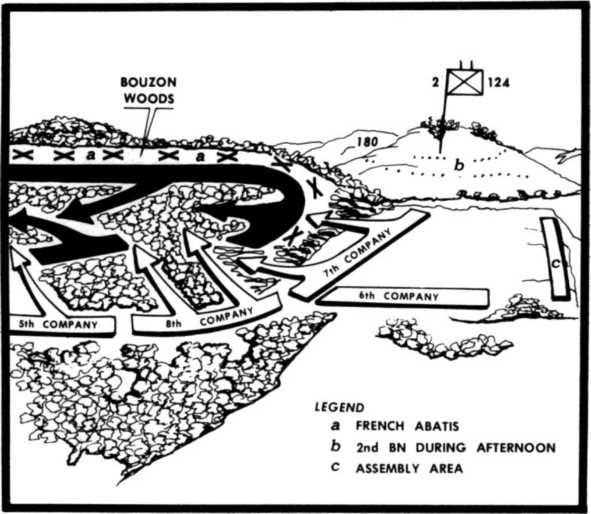We were again alerted on the afternoon of September 21 and pulled out for Apremont where we were ordered to relieve a battalion of the 125th Infantry, then in the front lines on a ridge one mile west of Montblainville. The relief was to be accomplished after dark. The new position had little to recommend it. —A front slope position, all portions in view of the enemy, wet trenches, much rifle and artillery fire which caused casualties every day. Contact with the rear possible only at night.”
In a pitch-black darkness, over loose soil, and again in a heavy downpour, we got across country guided by a detachment from the unit to be relieved. The relief was completed at midnight. The sector we had taken over consisted of short, discontinuous two-foot-deep trenches full of water. The garrison was lying a short distance to the rear with the men wrapped in their overcoats and shelter halves. We were told that the enemy was a few hundred yards in front.
The troops soon had the situation well in hand. Using mess kits, they bailed the water out of their trenches and then started to deepen and improve them. Defuy Woods had taught them the value of trenches. Work went ahead rapidly in the soft ground, and at the end of a few hours most of the trenches were interconnected. The battalion could now look forward to the coming day without worry.
On September 22, the sun finally shone again. During the early hours all was peaceful in our sector. The enemy was some five to six hundred yards to our right on the edge of the Argonne forest. There was no sign of him along the Montblainville-Servon highway, which lay dead ahead of us. Off to the left, the enemy occupied a bit of woods along the same highway. In spite of the relatively short range, we were able to move about outside the trenches without being fired on. Under these circumstances, the ripe plums on the trees close to our positions were quickly picked. Around 0900, a French battery began to lay its fire on our new trenches. to our spade work during the night, the casualties were light.
Thirty minutes later the fire ceased, and during the next few hours we were subjected to occasional harassing fire. Up to noon we saw nothing of French infantry, and a reconnaissance detachment left to find the location and strength of the enemy in the woods to our right.
Some 50 yards from the edge of the woods, the reconnaissance unit came under spirited enemy fire and was forced to withdraw, leaving behind some severely wounded men. From our position, we had been providing covering fire for this sortie, and as the firing died away several French infantrymen and a first aid team were observed approaching our wounded lying in front of the French line.
Apparently, their intention was to evacuate our wounded but upon reaching them began to shoot the defenceless men where they lay. This base conduct so incensed our troops that retaliatory fire broke out immediately. In order to rescue our comrades, we would have to carry this portion of the woods by direct assault. Later in the day we did just that.
In the afternoon the kitchens arrived in the depression half a mile north of our position. In spite of the very lively harassing fire of all arms, carrying parties were able to get food clear up to the troops in the front lines.
At 1500 I went to the regimental command post in the vicinity of Hill 180, about a mile northwest of Montblainville where I was given the situation and the attack order for the 2nd Battalion. Strong enemy forces were located behind an abatis in the Bouzon Woods along the Montblainville-Servon highway. All frontal attacks by the 51st Brigade on our right had failed. East of the Argonne and to our left, the 1st Battalion, 122nd Infantry, reinforced by the 1st Battalion, 124th Infantry, was attacking through Montblainville against the hills eleven hundred yards south of the town and was making good progress.
At twilight the 2nd Battalion was to attack the enemy behind the abatis on the Montblainville-Servon road, take him in flank, and roll him up to the west. A neat but tough mission.
On my way back I studied the terrain carefully and considered the best means of carrying out our attack. To rush from our present position with the Montblainville-Servon road as initial objective seemed unattractive, for such an attack would not achieve surprise; would be subjected to flanking fire from the woods, and would cost us many casualties before reaching the highway. Finally, it would not place us on the Frenchmen's flank.
Having transmitted the regimental order, I made the following suggestion to the battalion commander: First, that we evacuate the positions on the hill a mile west of Montblainville and assemble the battalion on the north slope of the hill where there was some cover; then, in a formation of considerable depth, advance up the draw to the east of our present position and seize the small woods seven hundred yards west of Montblainville. (Sketch 8)
This small woods had been shelled by our artillery a short time before and to all appearances was deserted. It was possible on account of the topography to execute our movements without being observed by the enemy.
Once in the woods, the Battalion could deploy to the west preparatory to an attack south of the highway against the eastern edge of the Argonne. Such an attack would strike the flank of the enemy lying along the Montblainville-Servon highway. If we moved out immediately we could still attack in the twilight.
My proposal was translated into action. By going back a man at a time, platoon after platoon managed to evacuate the positions on the south slope. A few men were slightly wounded by lively rifle fire. The whole battalion was soon assembled on the north slope. The enemy continued to fire at the empty positions. We advanced in column of files, the battalion staff leading, toward the small woods seven hundred yards west of Montblainville. The Frenchmen, oblivious of our departure, were still pasting our empty positions.
We reached the little woods without being detected. A shallow rifle trench ran along the north edge where we found a few pieces of equipment such as packs, canteens, and rifles. The former occupants had probably deserted the trench during the afternoon because of German artillery fire. We deployed to the west and prepared to attack the enemy at the edge of the woods. He seemed unaware of our presence; at least we had not been fired on from that direction.
Our objective was up a slope about a quarter of a mile away. Six hundred yards south of the highway, we located a good, covered avenue of approach leading directly into the position, and the 5th Company was brought up this draw to within a hundred yards of the edge of the woods. In the meantime the 7th and 8th Companies assembled between the highway and the draw. The 6th Company constituted the battalion reserve. The staff was up with the 5th Company. The companies were given their orders. Our plan was to surround the enemy established along the highway. The formation was echeloned to the left. (Sketch 9)

Sketch 8
Manoeuvring from frontal to flanking position west of Montblainville.
It was getting quite dark when Major Salzman gave the attack signal. The approach was made without noise, and soon the leading files of the 5th Company reached the forest. The 7th and 8th Companies were about three hundred yards from the edge of the woods. There was no sign of the enemy. His attention appeared to be focused on our old positions north of the highway.
The 5th Company continued on through the underbrush and together with the battalion staff was soon lost among the trees.
Suddenly the 7th Company ran into the enemy along the highway, and a short fire fight got under way at ranges of a hundred yards or less. 5th Company and Battalion staff turned right. 8th Company and the left wing of 7th Company turned half-right and then, with a mighty shout signalling the charge, the entire battalion fell upon the enemy.

Sketch 9
Flank attack along the Montblainville-Servon Road. View from the south.
The abatis in front of the French proved useless. Our powerful surprise thrust on his flank and rear scored tellingly. Panic seized the defenders of the abatis and the reserves. Those who did not fall to bullet, bayonet or rifle butt fled headlong to the west. Thus was a full measure of revenge exacted for our murdered wounded of that afternoon. Only darkness brought an end to the carnage. Fifty prisoners, several machine guns and ten artillery limbers were taken as well as a warm evening meal bubbling in the kettles over open fires.
We were not without our own losses, however, and mourned our casualties— Lt. Paret and three men killed; one officer and ten men wounded.
Our assault had some side effects. The panic on their right wing infected the entire French Brigade which hastily abandoned a very strong position behind an abatis, and during the night, the 51st Wurttemberg Brigade captured a large number of these stragglers near the intersection of the Montblainville-Servon road and the Roman Road. (See sketch 8)
The battalion bivouacked on the spot. Without straw and with only our coats to wrap around us, the damp ground chilled us to the bone on this cool September night. Our horses, however, were able to eat their fill of captured oats.
On September 23 at daybreak, I accompanied Colonel Haas on a reconnaissance as far as the old Roman road. After this the 2nd Battalion received orders to move south along the eastern edge of the Argonne Forest as far as Les Escomportes farm. While I was still at the regimental command post, my battalion, contrary to orders, marched off through the woods and I could find no trace of them. I tried to get down to Les Escomportes farm by going along the eastern edge of the woods, but noticed that the French still occupied the place and that they had machine-guns. I did not find the battalion until afternoon, by which time it had advanced through the woods, bypassed Les Escomportes farm; reached the hill eleven hundred yards south of the farm, and had driven off the few outposts found there. By the time I caught up, the French were using artillery on us again. It is a mystery to me how they obtained our location in the middle of a woods and how they managed to deliver effective fire in so short a time.
The hungry and tired men lay down under trees and in some improvised shelters the French had built out of branches. They had gone without food since early morning, and I rode back to get the kitchens which were located in the vicinity of Apremont. I located them half a mile north of Montblainville. It turned out, however, that the horses were in no condition to negotiate the soft ground between there and the outfit. They got stuck a quarter of a mile east of Les Escomportes farm, and the units were fed piecemeal between midnight and 0300.
In the meantime, a regimental order had been received ordering us to be at Les Escomportes farm by 0500; consequently, we got little sleep.
Observations: The relief of a front-line battalion at night— Guides must lead the way. The relief must be noiseless, otherwise the enemy can break up the movement and cause needless casualties simply by opening fire.
Again the 2nd Battalion made good use of the spade before daybreak and survived the enemy artillery bombardment with but few casualties.
Combat reconnaissance—It is advisable to have strong fire support ready for such a reconnaissance as was made during the forenoon of September 22. Losses are thus avoided. Under certain circumstances it is advisable to furnish a light machine gun for fire support.
On September 22, the 2nd Battalion succeeded in evacuating a position on a forward slope in daylight with few casualties in spite of the fact that the enemy was only six hundred yards away. Men withdrew singly. In my opinion, such a manoeuvre would be possible today. Of course, the enemy would have to be held down by artillery and heavy infantry weapons. Also, the employment of smoke would make such a movement easier.
The evening attack of the 2nd Battalion in the flank and rear of the enemy, who was strongly entrenched in the Argonne Forest, was a great success and cost us little in casualties. We were able, thanks to the terrain, to attack with our left company well out, and the formation paid off when we made contact, for we were then able to turn the right flank. The spread of panic among the whole brigade resulted in our capture of the entire position.
The night of September 23-24 provides a good example of ration supply difficulties in a war of movement.




 World History
World History









